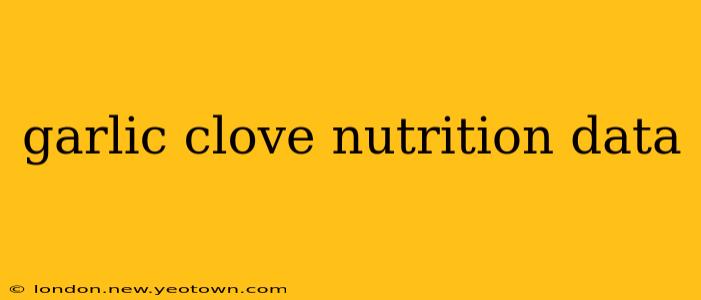Garlic, that pungent bulb we often associate with savory dishes, is far more than just a culinary staple. It's a nutritional powerhouse packed with vitamins, minerals, and bioactive compounds that offer a surprising array of health benefits. Let's peel back the layers (literally!) and explore the nutritional data behind this humble yet mighty clove.
What are the Nutritional Benefits of Garlic?
A single, average-sized garlic clove (about 1 gram) contains a surprisingly robust nutritional profile. While the exact values can vary slightly depending on factors like soil conditions and growing methods, a general picture emerges: Garlic is a good source of manganese, vitamin B6, vitamin C, and selenium. It also provides small amounts of other essential nutrients. But it’s the presence of potent compounds like allicin that truly sets garlic apart.
Allicin, formed when garlic is crushed or chopped, is responsible for much of garlic’s purported health benefits. This sulfur-containing compound is a powerful antioxidant and possesses antimicrobial properties. It's important to note that these benefits are maximized when you consume raw or lightly cooked garlic, as significant allicin loss occurs during prolonged cooking.
How Many Calories are in a Garlic Clove?
Surprisingly low! A single garlic clove boasts only about 4 calories. This makes it a guilt-free addition to nearly any dish, adding a burst of flavor without significantly impacting your calorie intake.
What Vitamins and Minerals are in Garlic?
While not a primary source of any single vitamin or mineral, garlic offers a respectable amount of several micronutrients that contribute to overall health:
- Manganese: Crucial for bone health, metabolism, and wound healing.
- Vitamin B6: Essential for brain development, immune function, and red blood cell formation.
- Vitamin C: A potent antioxidant that supports the immune system and collagen production.
- Selenium: A powerful antioxidant that protects cells from damage and plays a role in thyroid hormone metabolism.
Is Garlic High in Carbohydrates?
Yes, garlic does contain carbohydrates, primarily in the form of fructans, a type of fiber. However, the amount is relatively small per clove, and this fiber contributes to digestive health.
What are the Health Benefits of Eating Garlic?
The health benefits attributed to garlic are largely due to its rich concentration of allicin and other bioactive compounds. These purported benefits include:
- Immune System Support: Allicin’s antimicrobial properties can help fight off infections.
- Heart Health: Studies suggest garlic may help lower blood pressure and cholesterol levels.
- Blood Sugar Regulation: Some research indicates garlic might improve insulin sensitivity.
- Antioxidant Properties: The antioxidants in garlic help protect cells from damage caused by free radicals.
Important Note: While the potential health benefits of garlic are promising, it's crucial to consult with your healthcare provider before using garlic to treat any health condition. Garlic can interact with certain medications, and excessive consumption might lead to side effects like digestive upset or bad breath.
How Much Garlic Should I Eat Per Day?
There's no single definitive answer to this question. The amount of garlic considered safe varies greatly depending on individual factors. Moderation is key. Starting with a small amount and gradually increasing consumption is a sensible approach. Remember to consult your doctor if you have any underlying health conditions or concerns.
This exploration into the nutritional data of garlic cloves reveals a food far more complex and beneficial than its humble appearance might suggest. It’s a flavorful and versatile ingredient that can significantly enhance both the taste and nutritional value of your meals. So go ahead, add a clove (or two!) to your next dish and savor the flavor – and the health benefits – it brings.

